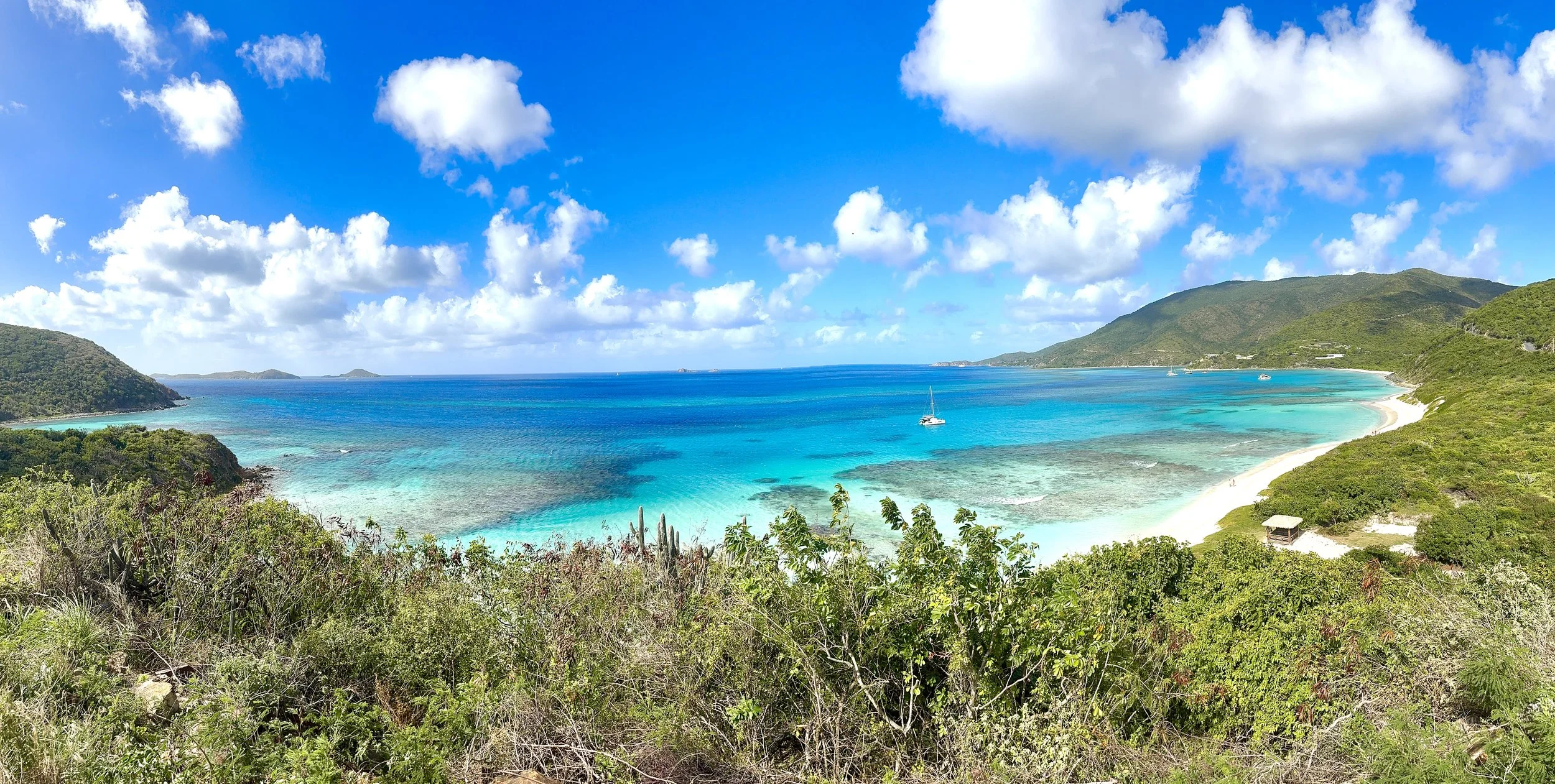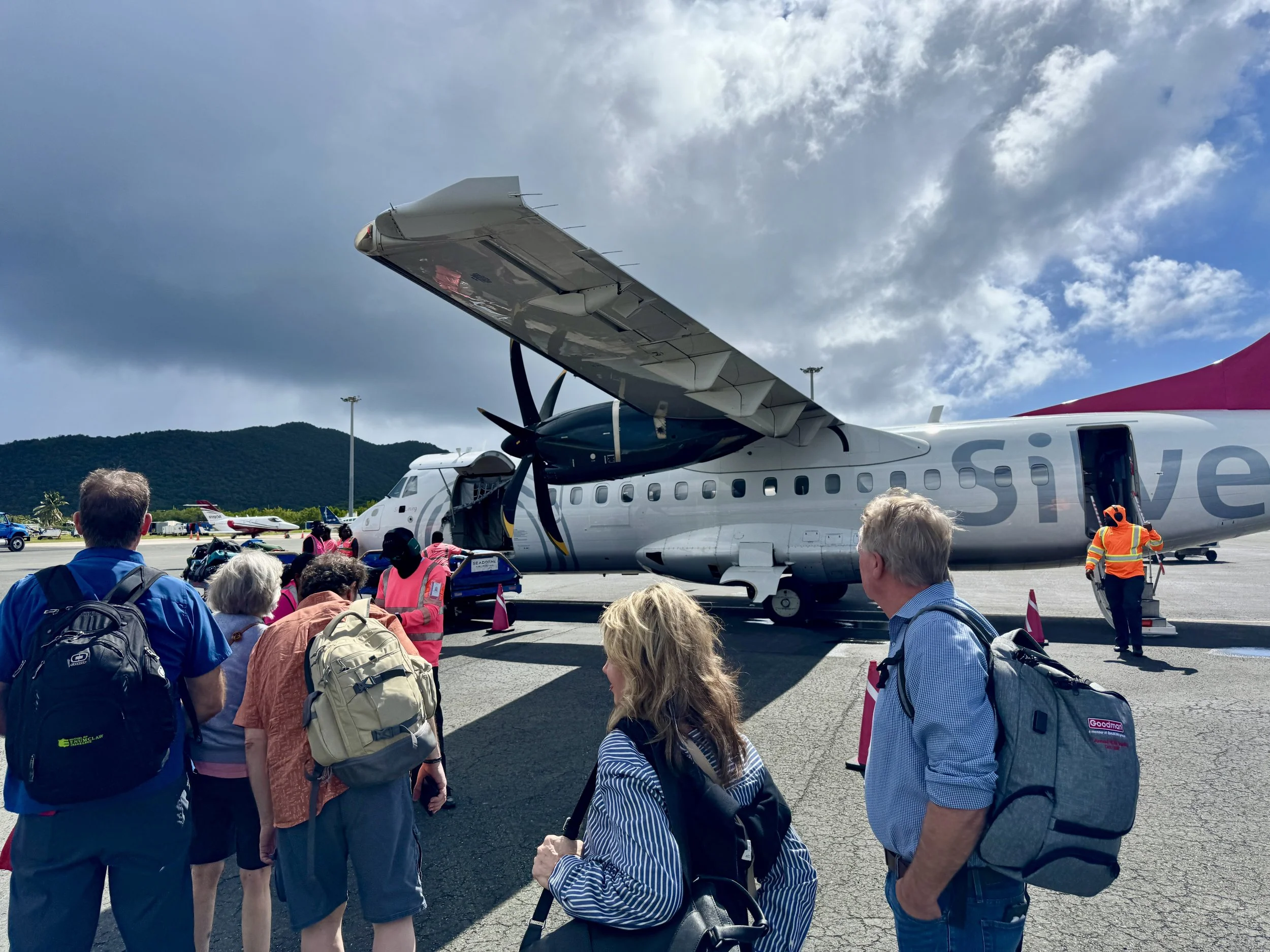
March 12th, 2025
Everything You Need To Know About Diving The R.M.S. Rhone
Join us as we break down everything you need to know about traveling to and diving Virgin Gorda in BVI’s
Virgin Gorda:
Ferry to an island that has Baths? Time to explain. Virgin Gorda is a Caribbean island in the British Virgin Islands, widely known for having the Baths—large granite boulders formed from cooled volcanic magma. This cooled magma created a stunning landscape of rock pools and cavern-like surroundings that, to be honest, is highly Instagram-worthy. In fact, I’m sure if you look it up, you’ll find plenty of Insta folks posing in that particular spot. Don’t judge—we did too.
This small island had such a friendly and positive vibe, from our Airbnb host to the local restaurants and dive shop. We happily soaked in the small island energy.
Getting There:
Alright, getting there was pure luck. We pride ourselves on doing thorough research before traveling, but this time, we ended up thanking the travel goddesses for putting us in the right place at the right time. We flew from Puerto Rico (SJU) to Tortola (EIS). Fun fact we didn’t know beforehand—Puerto Rico is actually a major hub for flights to various Caribbean islands, with departures running at all hours.
Okay, wait. Let’s backtrack.
We flew into SJU, followed the signs to the Uber pickup, got a driver fairly quickly (surprisingly, since it was about 9:30 PM), and stayed at the Embassy Suites close to the airport (~10-minute drive). Checked in, grabbed a Piña Colada at the hotel bar (Fun fact: Piña Coladas were invented in Puerto Rico!), and wow—probably the best one we’ve ever had. The next morning, we had a solid complimentary breakfast—not just a basic continental one, but actual hot food. Perfect fuel for the day. After breakfast, we Ubered back to the airport and took off for Tortola.
Our flight had been changed to two hours later, which we knew weeks in advance. What we didn’t know? When we strolled up to the gate hours early, the gate agents were already boarding! Cue the panic. We, along with other leisurely travelers, hurriedly got scanned in and realized we had plenty of time after all.
While waiting, we met an awesome couple renting a sailboat for their mom’s birthday. What an adventure! We also got our first glimpse of the tiny planes that store luggage in the wings. With our heavy dive gear in our carry-ons, we were a bit nervous. When the gate agent called our group, we hoped our bags wouldn’t be flying separately in those tiny compartments. Turns out, we lucked out with a much larger plane. Crisis averted—until we realized our rolling carry-ons didn’t fit in the overhead bins. Note to self: Check these bags when flying smaller planes. Thankfully, our backpacks fit, and the flight attendants helped us out (probably watching our mini panic attack). The flight itself was about 45 minutes.
Upon arrival, we went through customs, answered questions about our stay, and got a passport stamp with our exit date. Then, we paid a $10 per person Environmental and Tourism Levy—worth it since it helps fund environmental protections and tourism initiatives. Bonus: you get a cool turtle card as a souvenir.
Exiting the airport, we were met by a helpful lady arranging taxis for passengers. We told her we were heading to Fort Burt Hotel, and she immediately called over an available driver. The drive was an adventure itself—gorgeous deep blue water on one side, steep hills on the other. Also, they drive on the left side of the road, so prepare yourself for that if you’re used to the right.
We checked in and decided to confirm the ferry schedule for Virgin Gorda. At the ticket office, we found out Speedy’s Ferry typically runs Monday through Saturday, but by sheer luck, they had an extra ferry running the next day (Sunday). Why? A cruise ship was coming in, and tourists often take day trips to the Baths. Thank goodness!
Ferry to Virgin Gorda:
We arrived early the next morning, only to find a long line at the ticket office. The wait was about 20 minutes. We got our tickets, checked our rolling bags, and waited to board. Speedy’s is a great option for traveling between the BVIs—backpacks are allowed onboard, and rolling bags get checked at no extra fee. Also, a round-trip ticket is cheaper than a one-way, so plan accordingly.
The ferry ride was about 40 minutes, and as soon as we arrived, tour trucks were ready to take passengers to the Baths. Since we had pre-booked a rental car, we spoke with a Speedy’s staff member, who arranged a ride to the rental location. Definitely saved us a long walk!
We checked into our Airbnb, got settled, and eagerly awaited our moment to dive!
Dive Days:
Dive 1 – The RMS Rhone
Our first dive on our 100 Dives of a Lifetime journey! We checked in at DiveBVI, met our crew—Jeff (Captain) and Victor (Divemaster)—and hopped aboard their spacious and well-maintained vessel. On the way, we picked up a diver straight from their sailboat! Apparently, DiveBVI offers this as a service if you’re moored nearby. How cool is that?
We moored up at the site, geared up, got our briefing, and descended into history. The famous pillars of the RMS Rhone caught our attention immediately. This first dive took us to the bow of the wreck, giving us a true sense of its size—310 feet long. Seeing it on the ocean floor was humbling.
We were watching a large grouper when—bam!—a barracuda stole the show, zipping right in front of our GoPro. Andrew had no clue it was coming, and I tried to warn him, but, well… underwater screams don’t travel well. Other highlights included pufferfish, eels and lobsters.
Dive Time: ~55 minutes | Max Depth: 86 ft
Back on board, Jeff captivated us with the eerie story of the Rhone. Long story short, this “unsinkable” ship encountered a hurricane, lost its anchor, and crashed into Black Point Rock. The impact caused the boilers to explode, and the ship split in two. Sadly, passengers were strapped to their beds (standard storm protocol back then), meaning many went down with the ship.
Dive 2 – The Stern & Artifacts
After ginger cookies (thank you, DiveBVI!), we moored at a second site to explore the wreck’s stern. Dive time: 50 min | Max Depth: 68ft. We saw the massive propeller, a marble floor, the famous captain's spoon stuck into the reef, and even artifacts like plates and bottles. And yes, we rubbed the lucky porthole #26! Fingers crossed for good fortune.
It was incredible to see how marine life has reclaimed the wreck over 150+ years. Truly a diver’s paradise.
Add-On Activity: The Baths
If you’re in or near Virgin Gorda, do not skip the Baths. There’s a $3 entrance fee, and the walk down takes about 10 minutes. Once you reach the first beach, the crystal-clear water and giant boulders create a surreal landscape. We swam, explored the famous Instagram spot (yes, it’s as stunning as it looks), and trekked through cavernous rock formations. Water shoes are highly recommended!
Bonus: The trail leads to a beautiful beach with a walk-up bar. Of course, we grabbed a drink and took it all in.
Final Thoughts:
Huge shoutout to DiveBVI for an epic experience! If you’re in the BVIs, diving the RMS Rhone is a must. Also, CocoMaya is a fantastic food spot—Andrew swears by the fish tacos.
Thanks for joining us on Dive #1 of our 100 Dives of a Lifetime journey! If you have questions, check out our destinations page or reach out—we’re happy to help.
Happy diving!
Common Q&A:
Q: Should I rent gear there or bring all my own?
A: If you're staying on one island you should bring your own gear. If you're traveling to multiple islands there are strict baggage weight limits for both checked and carry-ons so if you can’t meet the requirements you can rent all your gear or just key pieces. I would 100% bringing your own dive watch and mask/snorkel
Q: Do I need a Visa to travel to the British Virgin Islands?
A: No, U.S. citizens do not need a visa to visit British Virgin Islands for tourism or business.
Recommended Gear:
2mm or 3mm shorty
Go Pro
Dive Light
Animals you might see:
Bottlenose Dolphins
Atlantic Spotted Dolphins
Common Dolphins
Spinner Dolphins
Eagle Rays
Southern Stingray
Humpback Whales (winter months)
Pilote Whales
Hammerhead sharks (Jan.-March)
Nurse Sharks
Caribbean reef Sharks
Hawksbill Turtles
Green Turtles
Best Time to Dive:
The best time to dive in the BVI is during the dry season, from December to April, when you’ll enjoy clear skies, calm seas, and excellent visibility. However, diving is available year-round.
How to Get There:
To reach Virgin Gorda, you’ll first need to enter the British Virgin Islands (BVI). Fly into Tortola’s Terrance B. Lettsome International Airport (EIS), where you can book a ticket with Speedy’s Ferry from either Tortola or Road Town. Keep in mind, the ferries operate only Monday through Saturday, so plan accordingly.
Dive Shops in the Area:
Dive BVI- We highly recommend this shop! The staff and boat crew are amazing and will make sure you have a good time!
Sunchaser Scuba- We don’t have any experience with this shop but if your staying over on the other side of the island this will be closer.
Top Local Dive Sites:
RMS Rhone- The Wreck of the RMS Rhone, built in 1865 and sank in 1867 off of Salt Island
The Kracken- The Wreck of the Kodiak Queen
Diamond Reef– 20-40 ft Novice
Dip ‘N’ Scrub– 20-60 ft Novice / Intermediate
Shark Point– 40-70 ft Intermediate / Advanced
Lee Bay – 50 ft Novice
Other Useful Information:
Local Time Zone: UTC-04:00
Phone Country Code: +1284
Local Currency: USD
Electrical Plugs Used: Type A, B
Local Voltage: 110V
Local Language: English
Most common 1st stages used: Yoke but you can request DIN tanks
International Airport and code: Terrance B. Lettsome Intl (EIS)


